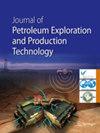Experimental investigation of the rock cutting process and derivation of the 3D spatial distribution of the formation strength using in-cutter sensing
IF 3.2
4区 工程技术
Q3 ENERGY & FUELS
Journal of Petroleum Exploration and Production Technology
Pub Date : 2023-10-21
DOI:10.1007/s13202-023-01712-4
引用次数: 1
Abstract
Abstract Recent advances in downhole measurements allow to accurately measure drilling forces at the drill bit, and estimate the evolution of the rock strength along the well profile. This paper presents an experimental methodology that allows to measure drilling forces, at the cutter scale, with a sensor embedded behind a polycrystalline diamond compact (PDC) cutter, and to infer the 3D spatial distribution of the rock strength. Two experimental campaigns have been performed on a laboratory-scaled drilling rig and complemented with standard mechanical tests to validate rock strength estimations. In the first campaign, homogeneous synthetic rock samples have been prepared. The average rock strength of each sample derived from cutter force measurements and a cutter–rock interaction model, compares well with the one derived from mechanical tests. In the second campaign, heterogeneous synthetic rock samples have been prepared. They are made of two layers of gypsum mixtures of different strengths, separated by a slanted bedding plane. Based on the instrumented cutter measurements, the 3D spatial distribution of the rock strength has been reconstructed along its path. Rock strength estimations are consistent with results obtained from mechanical tests, and the reconstructed geometry of the bedding plane matches well its actual geometry. The experimental methodology and technology presented in this paper lay the foundations for estimating rock properties in 3D, at the drilling stage. It has the potential to provide geoscientists information about complex lithological structures at an early stage, reducing the need for expensive and time-consuming coring and logging operations.

基于刀内传感的岩石切割过程实验研究及地层强度三维空间分布推导
随着井下测量技术的发展,可以精确测量钻头处的钻井力,并估计岩石强度沿井剖面的演变。本文提出了一种实验方法,该方法可以通过嵌入在聚晶金刚石紧凑型(PDC)刀具后面的传感器,在刀具尺度上测量钻井力,并推断岩石强度的三维空间分布。在实验室规模的钻机上进行了两次实验,并辅以标准力学测试来验证岩石强度估计。在第一次活动中,制备了均匀的合成岩石样品。根据切削齿力测量和切削齿-岩石相互作用模型得出的每个样品的平均岩石强度与力学试验得出的结果相当。在第二阶段,制备了非均质合成岩石样品。它们由两层不同强度的石膏混合物组成,由倾斜的层理平面隔开。根据刀具测量结果,重建了岩石强度沿其路径的三维空间分布。岩石强度估算值与力学试验结果吻合较好,重构的顺层面几何形状与实际几何形状吻合较好。本文提出的实验方法和技术为在钻井阶段进行岩石三维性质估计奠定了基础。它有可能在早期阶段为地球科学家提供有关复杂岩性结构的信息,从而减少对昂贵且耗时的取心和测井作业的需求。
本文章由计算机程序翻译,如有差异,请以英文原文为准。
求助全文
约1分钟内获得全文
求助全文
来源期刊
CiteScore
5.90
自引率
4.50%
发文量
151
审稿时长
13 weeks
期刊介绍:
The Journal of Petroleum Exploration and Production Technology is an international open access journal that publishes original and review articles as well as book reviews on leading edge studies in the field of petroleum engineering, petroleum geology and exploration geophysics and the implementation of related technologies to the development and management of oil and gas reservoirs from their discovery through their entire production cycle.
Focusing on:
Reservoir characterization and modeling
Unconventional oil and gas reservoirs
Geophysics: Acquisition and near surface
Geophysics Modeling and Imaging
Geophysics: Interpretation
Geophysics: Processing
Production Engineering
Formation Evaluation
Reservoir Management
Petroleum Geology
Enhanced Recovery
Geomechanics
Drilling
Completions
The Journal of Petroleum Exploration and Production Technology is committed to upholding the integrity of the scientific record. As a member of the Committee on Publication Ethics (COPE) the journal will follow the COPE guidelines on how to deal with potential acts of misconduct. Authors should refrain from misrepresenting research results which could damage the trust in the journal and ultimately the entire scientific endeavor. Maintaining integrity of the research and its presentation can be achieved by following the rules of good scientific practice as detailed here: https://www.springer.com/us/editorial-policies

 求助内容:
求助内容: 应助结果提醒方式:
应助结果提醒方式:


